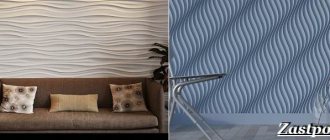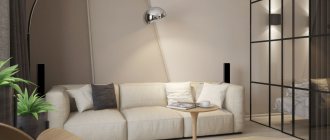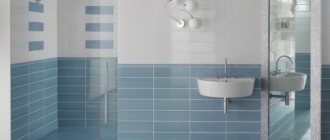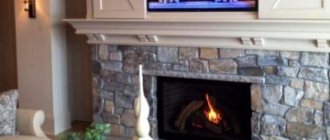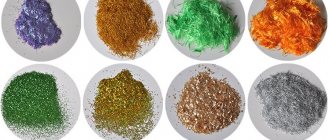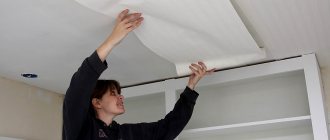Many people are simply tired of traditional wallpaper and decorative plaster. I want something unusual, original and fashionable. Drawings on the walls in the apartment are the ideal solution.
Surprisingly, this is a simple water-based paint plus fantasy
For example, it’s unpleasant for me if, when I come to visit, I see wallpaper or tiles that are the same as mine. I think I'm not alone in my aesthetic preferences. What to do? How to create original and exclusive decor?
Vivid examples of wall decor - simple but tasteful!
Those who have artist friends are lucky - oil painting on plaster is amazing, but too expensive. Are there more affordable options that will also look stylish and impressive?
Available original decor options
Fashionable black and white combinations
There are several techniques that can be used to decorate walls and ceilings:
- Pencil drawings on the wall - using a stencil.
- Decoration with textured liquid wallpaper.
- Extraordinary “mix” coloring.
- Frescoes.
- Stickers using 3D technology.
Such a sticker costs up to 500 rubles
All these techniques allow you to decorate walls yourself. The only requirement is that repairs must be made first. For effective decoration you need a smooth, specially treated base.
Ease of installation is another advantage of stickers
How to create a three-dimensional image on the wall
There are several ways to create 3D decor in your home. The easiest way to implement it would be to order a finished image printed on fabric or other material. After production, you just need to fix the coating in the right place and enjoy the result.
Such 3D wall paintings can be used anywhere - in the bathroom, kitchen or living room. You just need to choose the right material on which everything will be drawn.
Another type of finished painting is a special type of wallpaper. Here you also don’t have to do anything yourself. You just need to go to the store and buy a suitable coating.
The cost of such wallpaper can vary greatly, depending on how realistic the volume effect will be.
There are coating options in which the image is complemented by special materials that imitate sand, plaster or other similar materials.
The next way to decorate your home by placing 3D drawings on its walls is to buy wallpaper with pictures painted with special paint. The effect of volume appears on them only when the picture is illuminated with ultraviolet light. Under ordinary lighting, these are undistinguishable coverings, sometimes even without visible ornaments at all.
However, as soon as you turn on the ultraviolet lamp, the image becomes three-dimensional and takes on completely different shapes.
The last type of such decor is suitable only for those who have artistic talent - to create a three-dimensional drawing on the wall with their own hands. At the same time, there are several techniques that include not only the use of paints. You can create a picture from decorative plaster, sculpt it from plaster or use the appliqué method - there are a lot of ways.
It is only important to decide which method will allow you to get the most worthy result, taking into account your own talents.
Stencil drawings - fun and fashionable
Original mirror design using color
You can make a stencil with your own hands, or even easier - buy it at a hardware store. There is now a small selection of interesting patterns and designs on sale, so hand-made ones are more interesting in terms of design.
Elegant and simple composition
Or you can make a simple but beautiful stencil yourself:
- As a basis for the stencil, we take any design you like, for example, a maple leaf. You can also download interesting drawings from the Internet and print them on a printer.
- The starting material is a durable and flexible transparent material. A transparent paper folder (thick) or a sheet of transparent thin plastic will do.
DIY stencils are exclusive!
Everything ingenious is simple!
- You can limit yourself to thick cardboard, but you need to treat it along the edges with PVA glue so that the paint does not smear during application and does not soak the outline. Or you can laminate it, which is much more reliable.
Simple drawing for beginners
- Fix the stencil on the wall using special glue, tape or tape. It is necessary to stick it carefully so as not to damage the plaster.
The graphics always look great
- After applying the paint using an aerosol, brush or roller, move the stencil further along the previously applied markings.
It is important to follow the basic rule - everything should be in moderation. You shouldn't do a lot of drawings. One is enough, but beautiful and stylish. You can place the decor in the corners of the room or create an original composition on one wall.
Contrasting colors are the trend for the 2020 season
- After the paint has dried, you can additionally coat the design with a matte or glossy water-based varnish, then the walls can be easily washed.
For example, I really like drawings in a graphic style. In this case, instead of paint, you can create pencil drawings on the walls. Any pencils and crayons will do, but I would like to share my impressions of pastels and wax crayons.
Pastels will help you realize your most vivid fantasies.
Pastel is a chalk consisting of coloring pigment, chalk and binding components.
- Soft (dry) pastel - available in more than 110 shades, mixes beautifully and allows you to create soft, smooth, “velvety” drawings.
Asian fantasies in lilac tones
- Oil pastel – this pastel is based on wax and mineral oil with the addition of dyes. This option is brighter and richer. Great for drawing on a simple stencil.
Decor for beginning artists
- Waxy - consists of wax and pigments. This is the most abrasion-resistant version of pastel, but a smooth plastered surface is required for drawing. The colors are bright and intense. Pairs beautifully with dry pastels.
Stained glass made with wax and regular stylus
Wax pencils - consist of natural wax, these are more expensive and are suitable for decorating children's rooms, as they are absolutely safe. There are pencils made of synthetic wax, the price of which is two times lower, and can be used in the decor of any room.
This decor in two colors with flow can be easily done with wax crayons
Unlike pastels, pencils can be used to create drawings in any technique (graphics, landscape, still life, shading).
Pastel and wax crayon – elegant sakura
Wax pencil drawings on the wall are very interesting, but how to work with these materials:
- The tip, end or side of a wax pencil allows you to make lines of varying thickness and saturation.
- The strokes can be shaded with a swab or just with your hands.
- When shading, you get an interesting “blur” effect that will hide some of the flaws in the drawing.
Liquid wallpaper and central composition with pastel and wax
- You can paint using mixed media - you can apply water-based paint over the lines drawn with a wax pencil - only those places where there is no wax will be painted over.
- It is convenient to sharpen a wax pencil with a paring knife or hold it under running hot water before sharpening.
Abstract patterns are not limited by strict lines
- If you want to draw with both dry pastel and wax, then first apply the pastel, and then the wax lines. Dry pastels simply won’t stick to wax.
Exquisite and delicate bedroom
- You can erase some lines or correct the drawing with a regular school eraser or a roll of white bread.
A melamine sponge is very convenient for any drawings - it removes almost all paint without a trace, helps to create a beautiful and clear outline.
Modern style graphics
Smooth lines graphics
Using a stencil and a set of simple pencils of varying degrees of hardness, you can also decorate a room or corridor in an original way. A drawing on the wall in a graphic style perfectly emphasizes the interior in the spirit of modern minimalism or in a consistent Asian style.
The child will be delighted
When starting to create, you need to take into account that a hard pencil (H) gives a thin light line, and a soft lead (M) gives a thicker and richer line. For shading and shading, it is better to use a pencil marked HM (hard-soft version of the lead).
Subtle monochrome design
This technique is convenient because the drawing can always be erased with a regular eraser or washed off with a sponge. Regular clear varnish will help fix the pattern on the wall. Interestingly, even ordinary hairspray also fixes drawings made with a simple pencil well.
Avoid small details in composition
An interesting idea for graphic drawings is to trace the outline of the shadow cast by a regular film strip projector. In principle, a lamp with a narrow shade would also be suitable. We need a directional beam of light to which we can attach a sketch of the drawing.
The pattern we need is displayed on the wall, and we simply outline it with a pencil and decorate it at our discretion.
Some features of painting on plaster
Complex stencil for acrylic paints
The stencil is ready, the colors have been selected and purchased. It's time to start decorating.
At this stage it is important to follow a certain sequence:
- The wall should be clean, ideally recently plastered. But you can also draw on light-colored wallpaper, as long as it is clean.
Don’t get carried away by the abundance of details in the composition, the simpler the better
- Using a ruler and level, apply markings, marking the edges of the stencil with a pencil. It must be positioned clearly vertically and horizontally, without distortion.
- Before applying paint, it is better to practice on a sheet of paper and choose the appropriate color and application technique.
Transfer the drawing to the wall
- Glue the stencil to the wall and begin applying paint. Acrylic dyes are suitable for any type of finish (they are universal and can be applied to any cladding), but it will be more difficult to wash them off the surface than pastel or wax.
A sponge is convenient for making shadows and transitions from one color to another.
- It is important that there are no drips. Therefore, we apply the paint in small portions with a brush, or better yet, with a sponge.
- We hold the brush straight, perpendicular to the wall and, as it were, drive the paint into the wall.
Applying drawings with a roller
A standardly designed and embossed pattern can be applied to the wall using a special roller, with two cylinders - for supplying paint and applying it in relief on a flat surface.
This process is no different from ordinary painting of walls, but even here you can show your imagination by using painted areas as a zoning tool.
Volumetric patterns using putty or liquid wallpaper
Textures and colors of liquid wallpaper
Three-dimensional drawings using painted acrylic putty look very impressive and additionally hide minor wall defects. The thickness of the putty layer can be from one to three millimeters. This pattern is also applied using a stencil, which is carefully removed when the putty layer dries a little.
Wallpaper pattern with acrylic plaster
After the pattern has dried, unevenness can be easily removed with a stiff sponge. You can paint the ornament after it has completely dried. For durability, the design instructions recommend additionally covering the pattern with a transparent water-soluble varnish.
Another interesting and fairly simple decoration technique is finishing with wet (liquid) wallpaper. Thanks to the large selection of colors and textures, you can create both abstract patterns and entire artistic compositions.
Don't be afraid of experiments and originality
The big advantage of this material is its texture and inclusion of various fractions (marble, metal chips, mica). Compositions made from liquid wallpaper can be either small, in the form of alternating medallions around the perimeter, or large (central) covering the entire wall.
But without proper experience, it is better to limit yourself to original small bas-reliefs that you can make with your own hands, using a stencil.
Summary
Even simple and uncomplicated drawings will give the room a special atmosphere
And yet, it seems to me that decorating the interior yourself, if you have time for it, is interesting and exciting.
The video presented in this article describes in detail how to make a stencil from thick paper. I invite you to share your design ideas in the comments. I am sure that there are many interesting nuances in this creative process.
You can decorate the interior and make it unique with the help of artistic painting on the walls. In this way, an exclusive design of the room is carried out, which creates a beautiful, cozy and unique atmosphere. There are many techniques for applying drawings to walls or ceilings. For this work, you can invite an artist or paint the surfaces yourself. Fortunately, there are many materials and auxiliaries available for sale that are used for artistic painting on walls. Therefore, to create an interior design you only need desire, a little imagination and creative skills.
Drawings in the children's room on the wall
This technique deserves special attention when creating the interior of a children's room. This is where you can fully use your imagination and imagination and come up with a new, original solution. You can make a drawing on both the wall and furniture. Children really like these drawings. This could be a character from your favorite cartoon or fairy tale. But there are some nuances.
We must remember that children do not like monochrome and contrast. They can cause fear and your baby will become skittish. But we have no use for it.
Therefore, all characters without exception should look colorful, be positive and kind. Drawings on the walls are well suited for the design of a small and narrow bedroom. This simple method will allow you to visually expand it and get a unique design.
Choose your color scheme carefully. For example, too dark or bright burgundy shades have a negative impact on the baby’s behavior and psyche. It is better to paint the nursery in light, pastel colors.
Surface preparation
It is not necessary to level the wall with plaster. For this, it is easier and more convenient to use sheets of drywall. They can be fixed to the surface using a solution or to a frame made of metal profiles. After this, you must first apply a starting layer of putty to the drywall, followed by a finishing layer of putty. Next, the surface is rubbed to a perfectly smooth state and primed. Finally, the background color for the future drawing is applied, after which you can begin painting.
The surface for future artistic decoration should be as flat and smooth as possible.
Main types and methods of application
For the creative process you will need interior paints, acrylic or water-based, you can use gouache. A simple pencil is needed for drawing sketches and markings. In certain cases, a stencil is used for painting.
The most common methods of drawing:
- painting;
- drawing a sketch with a pencil;
- by slide projection;
- creating a picture using shadows;
- stencil drawing technique;
- making relief images.
Perhaps only experienced artists with well-developed spatial thinking can immediately transfer a drawing to the wall with paint. If you do not have enough experience, it is better to first draw the image with a simple pencil, and then use paints. Using a slide projection machine, you can display any picture on the wall, trace its contours and decorate it with paints. A very unique technique for creating shadow painting. Under certain lighting, shadows of objects will fall on the wall; it could be lace, a vase, a human figure; here you can experiment and find the most unexpected solutions. The shadow is outlined with a pencil and then filled in with the selected shades. It is convenient and easy to use stencils in drawing. They can be purchased at the store or made yourself. Relief images are created using gypsum mixtures.
DIY drawings
Making an artistic painting in the interior with your own hands is not so difficult. Of course, you should not expect that such drawings in the interior will become masterpieces of fine art. But of course it will be possible to create your own unique composition that will effectively transform the room and be a remarkable decoration of the house. Using a slide projector, it is easy to display an image of any complexity, accurately outline its contours, and then decorate the drawing with paints - any amateur can do it. And even children can use stencils. And if you have good creative skills and good imagination, then with due diligence and care, you will achieve simply impressive results.
First, you should decide on the choice of picture and its location. It is advisable to choose a wall opposite the window that is well lit. If the selected location receives little light, you need to provide additional lighting above it, for example, install LED lamps. To create an artistic composition, you will need to purchase paints, three brushes of different sizes, and you can start creating.
Beginners are advised to use no more than three colors for a drawing.
Even from three colors it is possible to create many shades. Therefore, do not rush to stock up on colors of all the elements of the rainbow; it is better that the image turns out harmonious and not tacky. Using one black color you can depict an incredibly effective abstraction or a monochrome composition in the style of a black and white photo. First of all, if necessary, apply a background; this should be done on a slightly damp wall. After this, a sketch is drawn, which is subsequently decorated with paints. At the end, the painting is carefully opened with transparent varnish. This way the drawing will be stronger and more durable.
Choosing a composition plot or ornament
Before choosing the desired drawing, it is worth considering that not everyone can complete realistic landscapes and portraits; for such complex multi-stage work, it is better to invite an artist. Well, many people can create an original, effective design, decorate a room with ornaments or patterns using a stencil.
The artistic composition should be combined with the interior design style and suit the character of the room.
It must be borne in mind that drawings and patterns can significantly change the space of a room. The higher and more spacious the room, the more space you can use for painting. In rooms with low ceilings, drawings and ornaments located vertically will allow you to visually raise the walls. It is not necessary to paint the entire wall; you can beautifully decorate the corner of the room, decorate door, window openings or partitions with patterns. If you can’t decide on a drawing, look at various works of art; this activity will definitely inspire you and allow you to borrow ideas you like.
Stencil painting
This simple and convenient drawing technique will allow you to create a beautiful painting and feel like a real artist. There are many stencils available in different sizes and thicknesses. The assortment allows you to choose elements of exquisite patterns and details to create a composition. It is most convenient to work with self-adhesive templates. They are easy to install and fit tightly to the wall, allowing you to get a neat design.
By the way, if you wish, it’s easy to create an original stencil with your own hands. To do this, you need cardboard or a plastic folder for papers, on which the image is placed and cut out with a stationery knife. Paint is applied to a stencil attached to the surface using a sponge or roller. After it dries, the template is removed and a pattern remains in its place, which, if necessary, can be corrected with a thin brush. It is also convenient to work with decorative rollers with protruding patterns, which are printed on the wall using paint.
In the nursery
For younger children, you can depict fairy-tale landscapes with funny and favorite characters. When decorating your baby's room, you need to use warm colors that will be pleasing to the baby's visual perception. Teenagers will enjoy fashionable anime, colorful comics, sports or music themes. Before choosing a drawing, it will be useful to consult with your child, who will tell you about his preferences, fantasies, and may give an interesting idea for future decorative painting in the nursery.
In the hall
Immediately crossing the threshold of the house, guests find themselves in the hallway, based on this, the first impression is created for the owners. Therefore, due attention must be paid to the design of the corridor. Artistic painting on the walls or ceilings of the hallway should be done with the highest possible quality. To do this, it is best to invite an artist who will be able to present the room in the best light with his work. In order to decorate the room yourself, it is recommended to choose simple designs.
Wall painting in the interior of establishments
Artistic interior painting often becomes the hallmark of a prestigious establishment, effectively emphasizing individuality.
This complex and expensive decoration technique is used for various rooms:
- children's institutions;
- bars, cafes, restaurants;
- the shops;
- night and sports clubs;
- offices and personal offices.
In most cases, children's institutions have a modest budget allocated for decorating the premises. In this case, artists perform subjects, compositions and stylized drawings that do not require complex execution techniques in order to create a painting at a lower price.
Each bar has a specific theme, jazz, sports, country, which the master tries to emphasize with decorative painting. Optical illusions and bright modern designs that create the effect of reverse perspective are popular for the decoration of cafes and canteens. Whereas for painting the interiors of expensive restaurants, soft muted tones are more often used to create a comfortable and relaxed atmosphere.
In shops, boutiques, and beauty salons, decorative painting emphasizes the establishment’s brand, field of activity, attracts visitors and distinguishes it from many similar places. In sports clubs, color design is directly related to motivation for physical activity. Nightclubs are mainly aimed at young people, which is what artists are guided by when choosing themes for wall decoration. In such establishments, luminous paints, optical illusions and chameleon designs are often used for painting. Classic themes and minimalist design are suitable for offices and personal offices.
It is very important for any establishment to emphasize its uniqueness in order to stand out among other similar places. In this case, decorating the interior with artistic painting is the most effective option for creating an exclusive environment.
When renovating an apartment or a separate room, the issue of wall covering is very important, because this will serve as the basis for the design of the entire room. In this article we will focus on painting walls yourself. But here we will look at a more interesting method - applying patterns on the walls of the apartment with our own hands.
Using paint, you can create drawings or abstract patterns on the walls of an apartment or room that will reflect your style and create homeliness.
What and where to paint on the walls?
If you choose the right pattern, you can get a decorative function, as well as visually expand and enlarge the room. Drawings in the apartment carry different meanings in different rooms.
In the kitchen, scenes with still lifes and old cities performed well. This creates additional comfort. Drawing in the bedroom should relax and calm you down. You can draw angels or flowers. Seascapes will complement the bathroom.
Panoramic views will please your guests from the first minutes of their stay in the living room.
Remember that drawings on the wall will not become something new in the world of design, but they allow you to get a unique solution when creating an apartment design. A painted wall can create a special atmosphere, show your character and personality, and the apartment or house itself will become more comfortable and cozy. The most important thing remains the fact that you can become the only person with such an interior, because any idea for wall painting is exclusive and unique in its implementation.
Technology for creating drawings on the wall
When painting walls, there are several main questions that need to be answered:
What paint is suitable?
Of course, you choose the color as you wish, this is your personal design decision. But the type of paint will determine its resistance to water, heat and, in general, how long it will last. We recommend using water-based paints; they tolerate heat and humidity well, do not peel off, the surface covered with them can be washed, and are suitable for all rooms in the apartment.
What do we paint with: a brush or a roller?
Before application, you need to make a plain background.
- Roller: it is better to use a roller for this; it is much faster to cover large, flat surfaces; the paint applies evenly, without leaving streaks.
- With a brush you will spend much more effort and time. It is suitable for smaller objects, reliefs, where the roller cannot reach hard-to-reach places (furniture: chair, cabinet, etc.).
TIP: When painting walls, it is convenient to use a brush in the corners, as an addition to a roller; it is also useful when working with stencils.
How to properly prepare a wall? What surface can I paint on?
If you have bare walls and you decide to paint them, then initially you need to level the surface , since all the unevenness is very visible on painted walls.
- Sandpaper is suitable for this (using a sanding machine, of course, will be much faster than doing it by hand).
- If there are cracks or scratches on the wall in that area, you need to apply putty and then level it again.
- Then wipe off the dust and apply a primer, preferably two layers.
- In order not to waste money and make really high-quality and durable repairs, before painting, remove the old coating (using special solutions),
- and then do everything described initially.
ATTENTION: The exception is special wallpaper for painting; paint applies to it easily and evenly, as that is what they are intended for.
Mesh - four-leafed
To make a template, you will again need thick cardboard and a flat plate. The cardboard needs to be cut into a square with a side of approximately 25 centimeters.
Using a plate, make 4 semicircles on each side
To make it easier to work with this template, you will need a pen again.
We apply the template to the surface and paint all 4 semicircles with a spray can. Make sure that the sharp ends of the pattern match exactly, then you will get an even mesh
Someone might argue that this is a stack and call the drawing quatrefoils, well, it depends on perception
Using stencils
The stencil method allows you to decorate walls with designs of varying complexity, regardless of artistic abilities. You can create even a very complex pattern just by purchasing the appropriate stencil.
And it will take much less time to create a drawing using a stencil than with hand painting. The range of drawings obtained by this method is very wide: flowers, trees, animals, insects, abstraction, and the list goes on.
For inspiration with this painting method, we offer a master class on creating a floral ornament.
Master class: Floral print
To somehow diversify the walls and not leave them just white, decorate them with a contrasting floral pattern created using stencils.
To do this you will need the following materials:
- Stencil
- Paint (white for the background and contrasting, in this case bluish with a tint, for the drawing)
- Brush (a small one with short, stiff bristles is best)
- Painting tape (only for attaching the stencil to the wall while you work, and not asking someone to hold it)
Progress:
- Clear the room by providing a comfortable approach to the wall. Apply white paint, thus creating a field for the drawing. Wait until it dries.
- Place the stencil on the wall and secure it with masking tape. It must be well fixed, since if it slides after painting begins, it will be difficult to return it exactly to its previous place.
- Dip the brush into the paint, then shake it out thoroughly or wipe it a little with a towel so that the paint does not drip, otherwise it may flow under the stencil and the design will be ruined. The brush should be almost dry. Start sketching the stencil.
Important: When painting, carefully watch your free hand so as not to leave fingerprints with paint on the white wall.
- When the stencil is drawn and the paint has dried, move it to the next place and repeat the previous steps. Continue until you have covered the entire wall.
- When the last paint has dried, place the furniture in place and enjoy the created design.
How to prepare a wall before painting
Before you start painting, you need to check the wall and prepare your work space.
Clean the wall
First of all, make sure that the wall is clean and does not have any moisture damage or structural problems such as cracks, chips, or dents. Defects can be repaired, but keep in mind that the crack may be a structural problem that may eventually show up on your wall.
Carefully inspect the wall for signs of mold, dirt, wax, oil or grease. If you find any, clean it thoroughly and remember that mold or mildew may return if the underlying cause is not addressed.
Even if the wall looks clean, it's still best to wash it with a mild soapy solution to ensure you're starting with as clean a slate as possible.
Next step: priming the wall
After all defects have been removed, that is, the wall has been cleaned, uneven areas have been puttyed and sanded, you can proceed to another important step: priming the wall. This is an important step in creating a painting or simply painting a wall because the primer will help the paint stick to the wall more firmly. In some cases, the primer can be applied twice.
